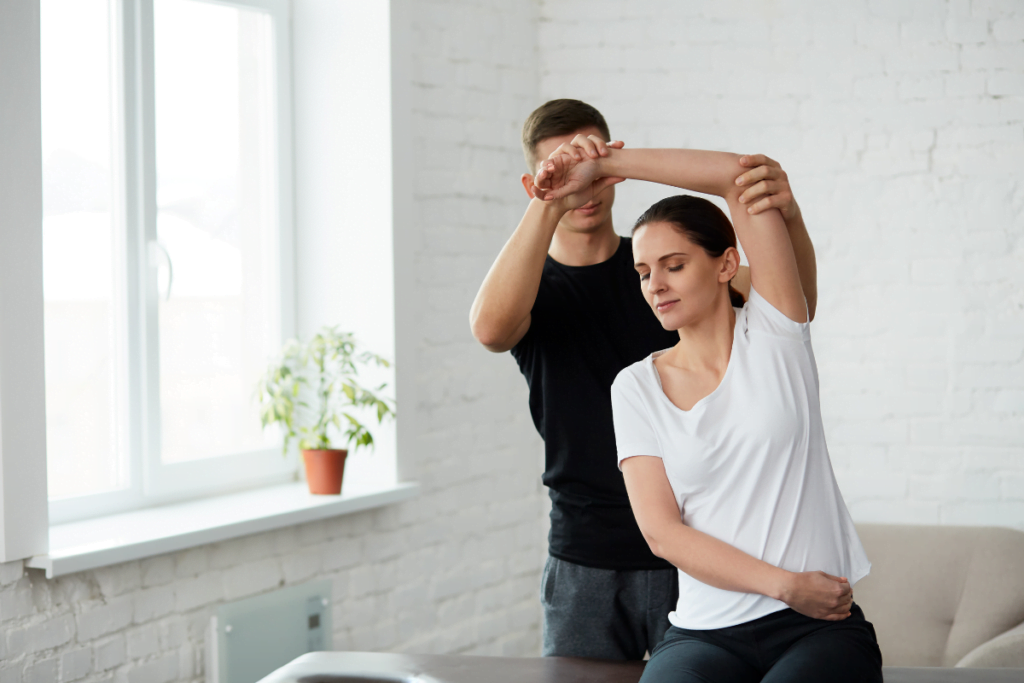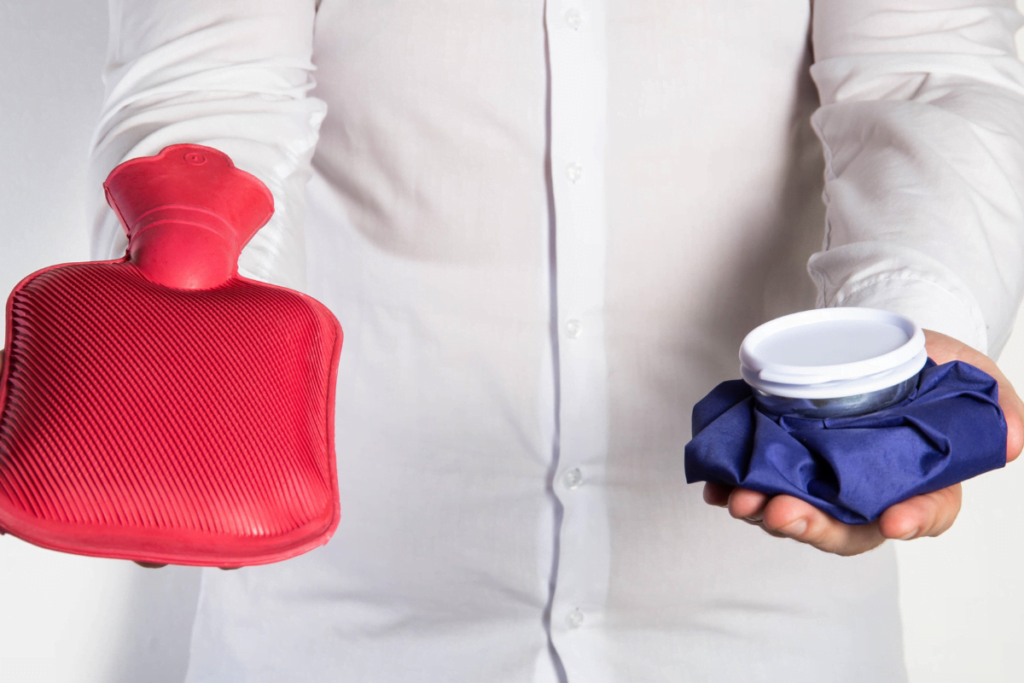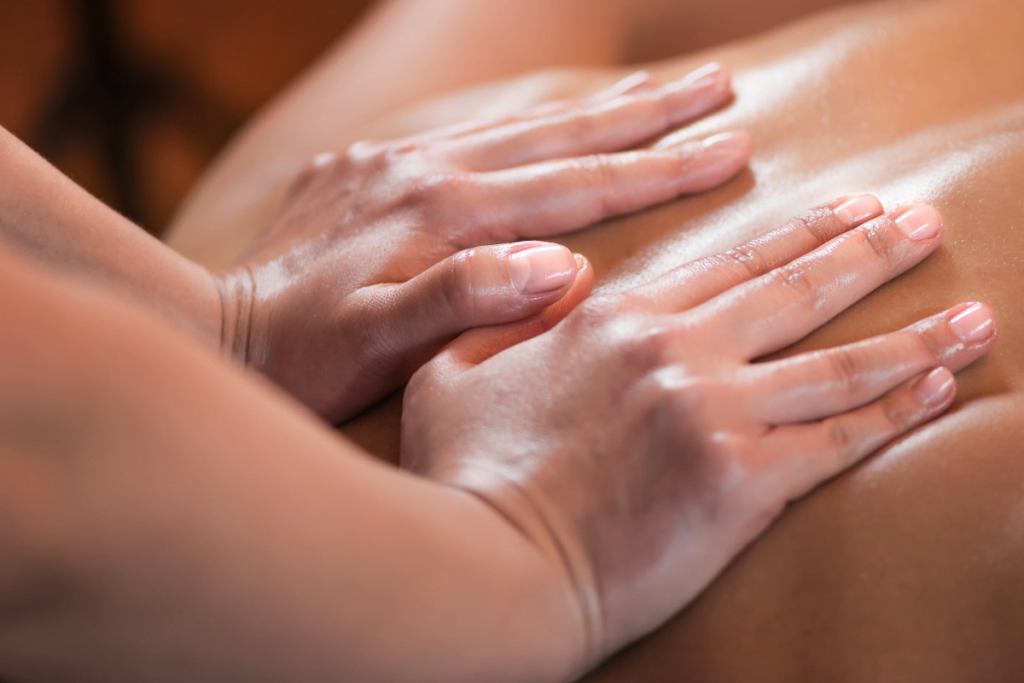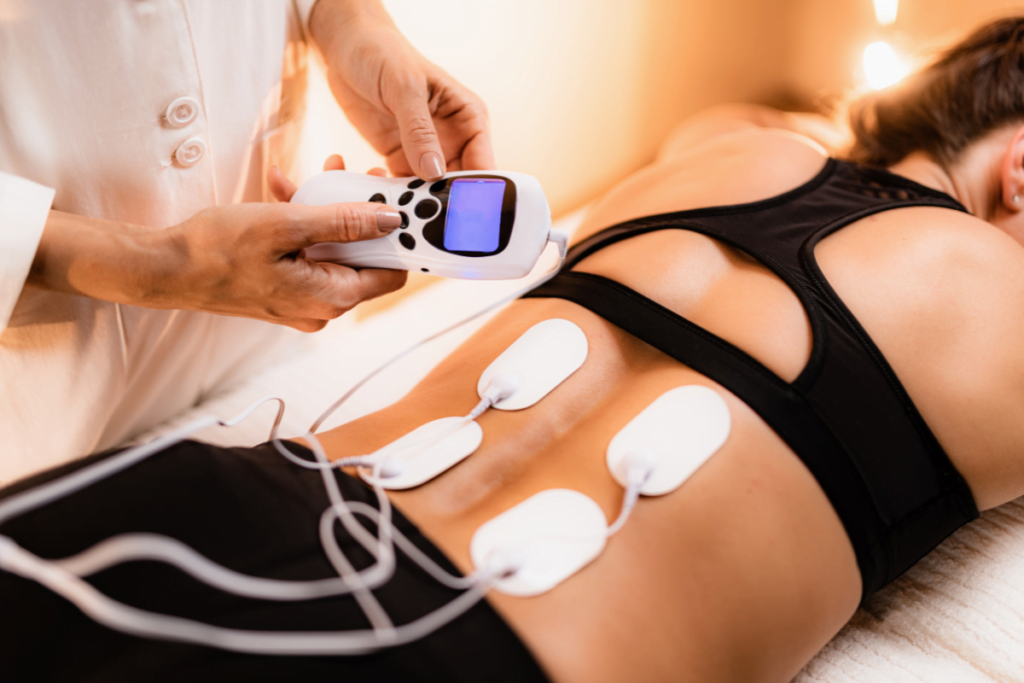Maintain Good Posture:
Maintaining good posture is essential for preventing and alleviating back pain. When you sit or stand with proper alignment, you reduce strain on your spine and surrounding muscles, which can help relieve discomfort and prevent future issues.
To achieve good posture while sitting, make sure your feet are flat on the floor, your knees are at or slightly below hip level, and your spine is straight with your shoulders relaxed. Use a chair with adequate lumbar support to help maintain the natural curve of your lower back. When standing, distribute your weight evenly on both feet, keep your shoulders back, and tuck your chin slightly to avoid slouching.
Be mindful of your posture throughout the day, whether you’re sitting at a desk, driving, or walking, and make adjustments as needed to keep your spine aligned and pain-free.

Ensure Ergonomic Work Environment:
Ensuring an ergonomic work environment is crucial for preventing and alleviating back pain, especially for those who spend long hours sitting at a desk. Start by setting up your workspace to promote good posture and reduce strain on your back. Invest in a chair with adjustable height and lumbar support to maintain the natural curve of your spine. Position your computer monitor at eye level to prevent neck strain and avoid reaching or straining to see the screen. Keep frequently used items within easy reach to minimize twisting or stretching movements.
Consider using a standing desk or alternate between sitting and standing throughout the day to reduce prolonged pressure on your spine. Taking regular breaks to stretch and move around can also help alleviate tension and improve circulation. By creating an ergonomic work environment, you can support your back health and reduce the risk of developing chronic pain or discomfort.

Use Heat Therapy:
Using heat therapy is a valuable way to relieve back pain and promote relaxation in the affected muscles. Heat helps to increase blood flow to the area, which can reduce stiffness and ease discomfort. There are various methods of applying heat therapy, including heating pads, heat wraps, warm baths, or even a hot water bottle wrapped in a towel. Simply apply the heat source to the sore area for about 15-20 minutes at a time, making sure to use a barrier like a cloth to protect your skin from direct contact with extreme temperatures.
Heat therapy is particularly effective for muscle spasms and chronic low back pain. However, it’s essential to use caution and avoid applying heat to areas of the body with inflammation or open wounds. Always consult with a healthcare professional if you have any concerns about using heat therapy for your specific condition.

Apply Cold Therapy:
Applying cold therapy is another effective method among the ways to relieve back pain, particularly for acute injuries or inflammation. Cold therapy, also known as cryotherapy, helps to reduce swelling, numb the area, and alleviate pain by constricting blood vessels and slowing down nerve impulses. You can apply cold therapy using ice packs, gel packs, or even a bag of frozen vegetables wrapped in a cloth to prevent direct contact with the skin.
Place the cold pack on the affected area for about 15-20 minutes at a time, several times a day, especially during the first 48 hours following an injury or flare-up of back pain. Remember to always use a barrier like a cloth or towel to protect your skin from direct exposure to extreme cold temperatures, which can cause frostbite. Cold therapy can complement other pain-relief strategies, such as heat therapy and medication, to help you find relief and promote healing for your back pain.

Incorporate Stretching Exercise:
Incorporating stretching exercises into your routine is a fantastic way to relieve back pain and improve flexibility and mobility. Stretching helps to lengthen tight muscles, reduce tension, and alleviate stiffness in the back and surrounding areas. There are several stretches specifically targeting the back that you can incorporate into your daily routine.
One effective stretch is the cat-cow stretch, which involves alternating between arching your back upward (like a cat) and lowering your belly toward the ground while lifting your head and chest (like a cow). Another beneficial stretch is the hamstring stretch, where you lie on your back and gently pull one leg toward your chest while keeping the other leg flat on the ground. You can also try the child’s pose stretch, where you kneel on the floor, sit back on your heels, and reach your arms forward while lowering your chest toward the ground.
It’s essential to perform these stretches slowly and gently, without bouncing or forcing your body into uncomfortable positions. Hold each stretch for about 20-30 seconds and repeat several times on each side. Consistency is key, so aim to incorporate stretching exercises into your daily routine to help prevent and relieve back pain over time. Additionally, consider incorporating other forms of exercise, such as yoga or Pilates, which can also provide significant benefits for back health and overall well-being.

Try Yoga for Flexibility:
Trying yoga for flexibility is a fantastic way to relieve back pain and promote overall spine health. Yoga combines gentle stretching, strength-building, and mindfulness techniques to alleviate tension, improve flexibility, and strengthen the muscles that support the spine. Many yoga poses specifically target the back, helping to release tight muscles and improve posture.
Poses like downward-facing dog, cat-cow stretch, and child’s pose can stretch and lengthen the muscles along the spine, reducing discomfort and increasing mobility. Additionally, yoga helps to improve body awareness and alignment, which can prevent future episodes of back pain by promoting proper posture and movement patterns.
One of the great things about yoga is that it’s accessible to people of all fitness levels and abilities. There are many beginner-friendly yoga classes and online resources available, making it easy to get started from the comfort of your own home. If you’re new to yoga or dealing with back pain, consider seeking out a gentle or restorative yoga class, which focuses on relaxation and gentle stretching.
As with any new exercise program, it’s essential to listen to your body and practice safely. If you have a specific back condition or injury, you may want to consult with a healthcare professional before starting a yoga practice to ensure that it’s safe for you. With consistent practice, yoga can be a valuable tool in your arsenal for relieving back pain and improving your overall quality of life.

Strengthen Core Muscles:
Strengthening your core muscles is essential for relieving back pain. Your core muscles, including those in your abdomen, back, and pelvis, play a vital role in supporting your spine and maintaining proper posture. When these muscles are weak, it can lead to imbalances and increased strain on your back, resulting in discomfort and pain. By incorporating exercises specifically designed to target the core, such as planks, bird-dogs, and Pilates, you can strengthen these muscles, stabilize your spine, and reduce the likelihood of experiencing back pain.
In addition to strengthening your core, it’s also essential to maintain overall physical fitness and flexibility. Regular exercise, including activities like walking, swimming, or yoga, can help improve muscle strength and flexibility, which can further support your spine and reduce back pain. Additionally, maintaining a healthy weight and practicing good posture throughout the day can also contribute to a healthy back. By taking a proactive approach to your back health and incorporating these habits into your daily routine, you can effectively relieve and prevent back pain, allowing you to enjoy a more active and pain-free lifestyle.

Use Over-the-Counter Pain Medication:
Using over-the-counter pain medication is one of the most common and accessible ways to relieve back pain. Medications such as ibuprofen (Advil, Motrin) or acetaminophen (Tylenol) can help reduce inflammation and alleviate discomfort associated with back pain. These medications work by blocking pain signals to the brain or reducing inflammation in the affected area, providing temporary relief from symptoms.
It’s important to follow the recommended dosage instructions and consult with a healthcare professional, especially if you have any underlying health conditions or are taking other medications. While over-the-counter pain medication can be effective for managing mild to moderate back pain, it’s essential to address the root cause of the pain and incorporate other strategies, such as exercise, stretching, and maintaining good posture, to prevent future episodes of discomfort. Always use pain medication as directed and consult with a healthcare provider if your back pain persists or worsens.

Consider Physical Therapy:
Considering physical therapy is a highly effective way to relieve back pain and address its underlying causes. Physical therapists are trained professionals who specialize in treating musculoskeletal conditions, including back pain. Through a personalized treatment plan, physical therapy aims to improve strength, flexibility, and mobility while reducing pain and preventing future injuries.
During physical therapy sessions, you may undergo various exercises and stretches tailored to your specific needs and abilities. These exercises target the muscles and tissues surrounding the spine, helping to alleviate tension, improve posture, and enhance overall spinal health. Additionally, physical therapists may utilize manual therapy techniques such as massage, joint mobilization, and spinal manipulation to reduce pain and restore function.
Furthermore, physical therapists provide education on proper body mechanics and ergonomic principles to prevent re-injury and promote long-term back health. They may also offer guidance on lifestyle modifications, including activity modifications and ergonomic workplace adjustments.
Overall, physical therapy offers a comprehensive approach to relieving back pain by addressing both the symptoms and underlying causes. By working closely with a physical therapist, you can develop the skills and strategies necessary to manage your back pain effectively and improve your quality of life. If you’re experiencing persistent or severe back pain, consider consulting with a physical therapist to explore how physical therapy can help you find relief.

Sleep Better:
Improving your sleep quality is a crucial aspect of finding relief from back pain. Poor sleep posture or discomfort during the night can exacerbate back pain and lead to restless nights. Therefore, implementing strategies to sleep better can significantly alleviate back pain and promote overall well-being.
One of the key ways to relieve back pain through better sleep is by investing in a supportive mattress and pillows. A mattress that properly aligns the spine and provides adequate support to pressure points can help alleviate back pain. Additionally, using pillows to support the natural curvature of your spine, such as placing a pillow between your knees when sleeping on your side or under your knees when lying on your back, can reduce strain on your back muscles and joints.
Maintaining a consistent sleep schedule is also essential for relieving back pain. Going to bed and waking up at the same time every day helps regulate your body’s internal clock and promotes better sleep quality. Additionally, creating a relaxing bedtime routine, such as taking a warm bath, practicing relaxation techniques like deep breathing or meditation, or reading a book, can help signal to your body that it’s time to wind down and prepare for sleep.

Good Posture:
Maintaining good posture is one of the most effective ways to relieve back pain and promote spinal health. By sitting and standing with proper alignment, you can reduce strain on your spine and alleviate discomfort. Ensure that your shoulders are back, your spine is straight, and your feet are flat on the ground when sitting, while standing, distribute your weight evenly on both feet and avoid slouching.
Incorporating ergonomic adjustments, such as using a supportive chair and positioning your computer monitor at eye level, can further support good posture and prevent back pain. By making conscious efforts to maintain good posture throughout the day, you can effectively relieve and prevent back pain while promoting overall spinal health.

Ice and Heat:
Using ice and heat therapy is an effective way to relieve back pain and promote healing. Applying ice packs to the affected area helps reduce inflammation and numb the area, providing immediate relief from pain. On the other hand, applying heat helps to relax tight muscles and increase blood flow to the area, alleviating stiffness and promoting healing.
Alternating between ice and heat therapy, known as contrast therapy, can further enhance the benefits by reducing pain and swelling while improving circulation. Whether you’re experiencing acute or chronic back pain, incorporating ice and heat therapy into your routine can provide significant relief and support your journey towards a pain-free back.

Hands-on Therapy:
Hands-on therapy, also known as manual therapy, is a valuable approach to relieving back pain and promoting overall spinal health. This type of therapy involves skilled manipulation of the muscles, joints, and soft tissues by a trained healthcare professional, such as a physical therapist or chiropractor. Through techniques like massage, joint mobilization, and spinal manipulation, hands-on therapy aims to reduce muscle tension, improve flexibility, and restore proper alignment of the spine.
By targeting areas of stiffness or dysfunction, hands-on therapy can alleviate pain, improve range of motion, and enhance overall function. Incorporating hands-on therapy into your treatment plan can complement other strategies for relieving back pain, such as exercise, stretching, and ergonomic adjustments. Whether you’re dealing with acute or chronic back pain, hands-on therapy offers a hands-on approach to finding relief and restoring your back’s health.

Nerve Stimulation:
Nerve stimulation is an innovative approach to relieving back pain that targets the nervous system to interrupt pain signals and promote pain relief. This technique involves the use of specialized devices that deliver electrical impulses to specific nerves in the body, effectively blocking the transmission of pain signals to the brain. One common form of nerve stimulation is transcutaneous electrical nerve stimulation (TENS), which uses electrodes placed on the skin to deliver low-voltage electrical currents to the affected area.
Another method, called spinal cord stimulation (SCS), involves implanting a small device near the spine to deliver electrical pulses directly to the spinal cord. These electrical impulses can modify the way pain signals are processed by the brain, providing significant relief for individuals suffering from chronic back pain. Nerve stimulation is considered a safe and non-invasive treatment option for relieving back pain and can be used alone or in combination with other therapies to effectively manage symptoms and improve quality of life.

Spinal Injections:
Spinal injections are a medical intervention used as a way to relieve back pain, particularly for individuals with chronic or severe symptoms. These injections involve the administration of medication directly into the affected area of the spine to reduce inflammation, alleviate pain, and improve mobility. One common type of spinal injection is epidural steroid injections, where corticosteroid medication is injected into the space around the spinal cord to reduce inflammation and relieve pressure on nerves. Another type is facet joint injections, which target the small joints in the spine to reduce inflammation and alleviate pain caused by arthritis or injury.
Additionally, nerve block injections can be used to temporarily block pain signals from specific nerves in the spine, providing relief for conditions such as sciatica or herniated discs. While spinal injections can offer significant relief for some individuals, they are typically used as part of a comprehensive treatment plan that may include physical therapy, medication, and lifestyle modifications. It’s essential to discuss the potential risks and benefits of spinal injections with a healthcare provider to determine if this treatment option is suitable for your specific condition and needs.

Back Surgery is the Ultimate way to relieve back pain:
Back surgery is considered a last resort in ways to relieve back pain, typically recommended only after conservative treatments have failed to provide sufficient relief. There are various types of back surgeries, each targeting specific issues contributing to back pain. For example, discectomy or laminectomy may be performed to relieve pressure on spinal nerves caused by herniated discs or spinal stenosis. Fusion surgery aims to stabilize the spine by fusing two or more vertebrae together, often recommended for conditions like spondylolisthesis or severe degenerative disc disease. Additionally, artificial disc replacement surgery may be an option to replace damaged discs while preserving motion in the spine.
While back surgery can provide significant relief for some individuals, it also comes with risks and potential complications. Recovery times can vary depending on the type of surgery performed and individual factors. It’s essential for patients to thoroughly discuss the potential risks, benefits, and expected outcomes of back surgery with their healthcare provider before making a decision. Additionally, rehabilitation and physical therapy are often necessary to help patients regain strength, mobility, and function following back surgery.
Overall, while back surgery may be an option for relieving severe or persistent back pain, it’s important to explore all conservative treatment options first and carefully weigh the potential benefits and risks before proceeding with surgery.





